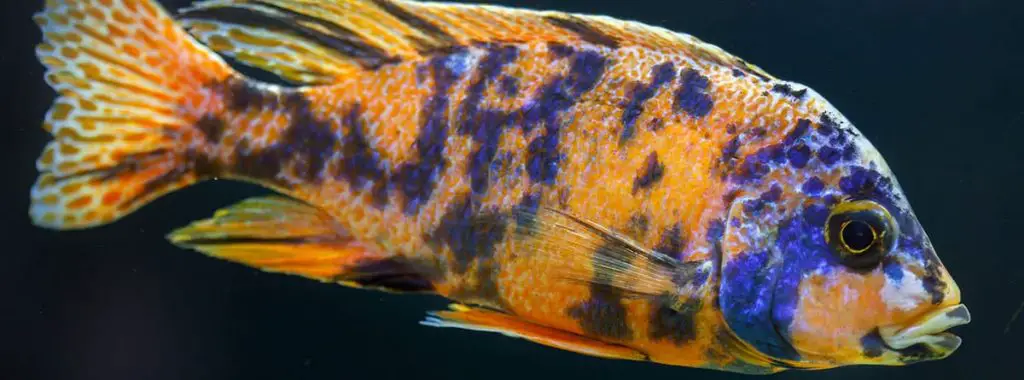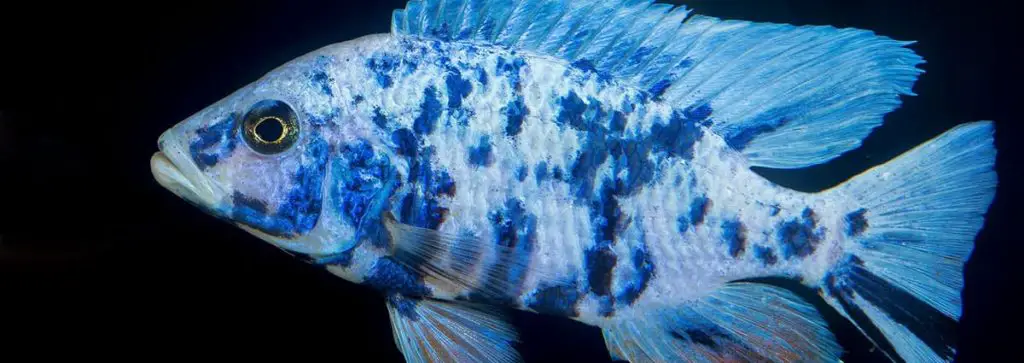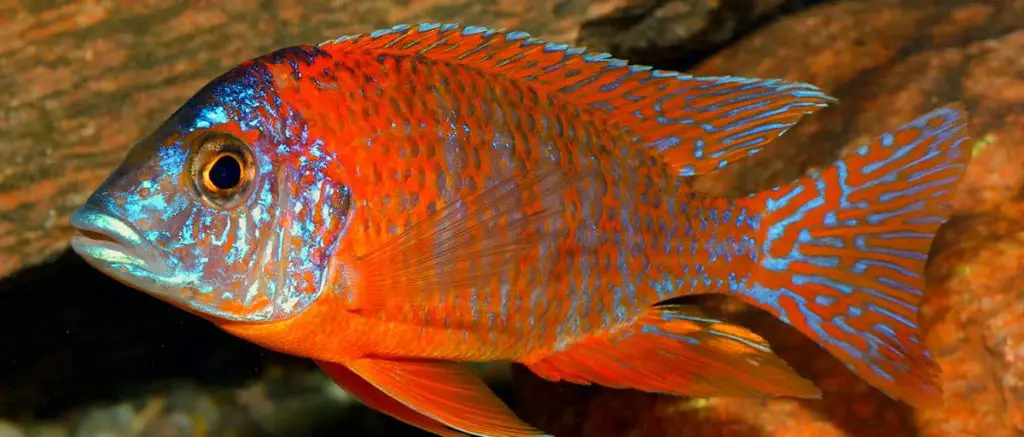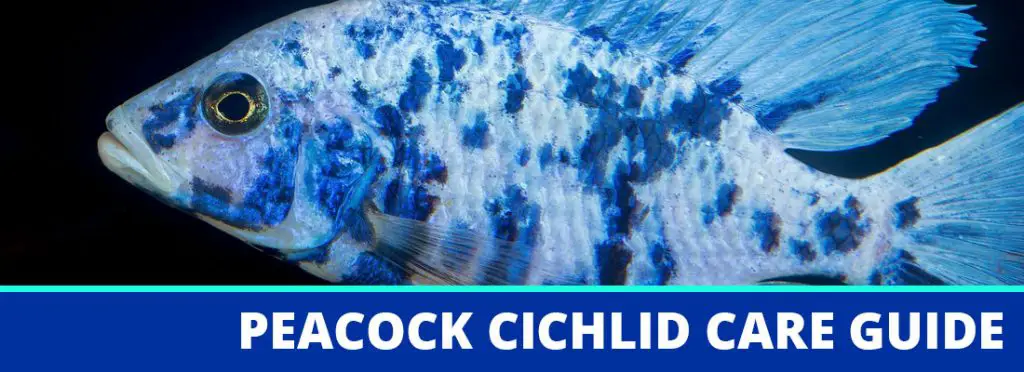If you are looking for a good sized aquarium fish with stunning colors, Peacock Cichlids are some of the best you will find in freshwater fish choices.
They are also very intelligent and curious creatures that make excellent pets. Since there are many different colors available, you can easily make a community tank and enjoy a wide variety of different looking fish.

Quick Intro To Peacock Cichlids
| Family Name | Cichlidae |
| Scientific Name | Cichla ocellaris |
| Other Names | Aulonocara Cichlids, African Butterfly, Sunshine Peacock, Maulana Bicolor, Red Peacock, Many Others |
| Care Level | Easy to moderate |
| Region of Origin | Lake Malawi, Africa |
| Distant Relatives | Other Haplochromis Cichlids, Mbuna Cichlids, Utaka Cichlids, Other African Cichlids |
| Habitat Type | Open, clean waters with some rocks and sandy substrate to dig in. |
General Appearance
Classical “Goldfish cracker” shaped body with sleek fins and bright, iridescent bodies.
They come in many different colors including red, orange, blue, and yellow. You can also find many with stripes, mottles, and blotches of color.
Males vs. Females
Females and juveniles of both species tend to be silvery or grey colored. Male Peacock Cichlids develop bright colors as they reach maturity.
How They Move in the Tank
They are fast, powerful moving fish that can chase or dart with precision.
Optimal Water Conditions For Peacock Cichlids
Since you will need a fairly large tank to house Peacock Cichlids properly, it may take several months for the tank to cycle.
| Water Temperature | 75.2 – 80.6 degrees fahrenheit |
| Water Flow Rate | Enjoys both rapidly moving and quiet water |
| pH | 7.8 – 8.6 |
| Hardness | Hard |
| Aquarium Salt (Y/N) | Yes |
| Tannins (Y/N) | No |
Tank Setup
| Minimum Tank Size | 50 gallon tank |
| Optimal Tank Size | 100+ gallons |
| Optimal Tank Shape | Large and low |
Best Filter Type
Overhead canister for the primary, and then 1 bubble up filter for every 10 gallons of water spread through the tank.
Use these to hold zeolites, reusable floss (to preserve the biofilter), and nitrate/nitrite absorbing pillows.
Extra Air and How to Provide It
Airstone curtains near the substrate and mid-levels of the tank.
Testing Schedule First Year
Test weekly for ammonia, nitrites, nitrates, pH, hardness, salinity, and carbonate levels.
Testing Schedule After 1 Year
Bi-weekly for ammonia, nitrites, nitrates, pH, hardness, salinity, and carbonate levels.
Even though Peacock Cichlids are fairly peaceful, they can become aggressive over territory. Before you add fish to the tank, it will be of some help to make sure you have a good fitting tank divider available.

Creating the Landscape
| Rocky substrate or gravel | No |
| Sandy substrate | Preferred |
| Overhangs and caves | Yes |
| Open water | Yes |
| Densely planted | Medium |
| Best Plants | Keep rooted plants in pots or use terraces with mesh over the substrate so the fish cannot dig in it. Most plants that enjoy alkaline water will do fine in a tank with Peacock Cichlids. |
| Best Lighting | Moderate |
| Best Decorations | Rocks, plants, caves, sandy areas for digging. These fish need some hiding places, but also a good bit of area to swim around openly. |
| Decorations to Avoid | Anything with sharp edges or plastic. |
Physiological Considerations
| Maximum Size | 4 – 7 inches |
| Rate of Growth | 2 – 3 years to approach full size. They will grow about 1 inch per year. |
| Life Span | 8 years |
| Temperament | Semi-aggressive and territorial among themselves, less inclined to show aggressive behavior to other species. |
| Preferred Tank Region | Mid level to bottom |
| Scale Thickness | Scales are fairly sturdy and can withstand most medications suitable for freshwater setups. Their slime coat and scales can still be easily damaged by rubbing or scratching against sharp or hard surfaces. |
| Gill Considerations | Peacock Cichlids don’t always like the kind of strong water flow that keeps gills healthy. Provide peaceful, relatively still areas and other areas with stronger currents to reduce the risk of gill flukes and other gill disorders. |
| Swimbladder Considerations | Despite being bottom dwellers, these fish should have no problem with reaching the surface or changing levels if they wish to do so. If you see signs of swimbladder problems, try reducing the amount of airflow at the substrate and mid tank levels. |
| Fin Shape Considerations | Strong, powerful fins that propel this fish easily and quickly through the water. |

Society
When compared to other Cichlid species, Peacocks tend to be less aggressive. However, this doesn’t mean you can safely house them with smaller fish or others that aren’t strong enough to take care of themselves.
Basic Psychology of Males and Females
- Males – Solitary and territorial. They will usually choose a cave or other overhang that will serve as a place to draw fertile females. Leave about 1 ½ feet (20” to 2 foot diameter) around each structure for each male in the tank.
- Females – Sometimes solitary, but will often school together.
- Male to Female Ratio – 3 females to 1 male
- Schooling Behaviors – Females will school, males won’t. They may or may not school with other species in the tank depending on their colors and body shape in relation to each other.
- Suitable Tankmates – Other Hap Cichlids
- Species to Avoid – Small fish, Mbuna Cichlids, Utaka Cichlids
If you are lucky enough to start off with a group of fish that get along well together, you may not see Peacock Cichlids becoming aggressive enough to do serious harm to each other. It is still best to prepare for any challenges in this area.
Common Behaviors You May See in Aggressive Peacock Cichlids
| Changes in Eye Color | No |
| Chasing | Yes |
| Circling with Fins Splayed | Yes |
| Fins Splayed as Other Fish Approach or When Approaching Other Fish | Yes |
| Intensified Colors | Yes. Brighter colored males, or males with stripes may also be more aggressive than less colorful males. |
| Mouth to Mouth Biting | Yes |
| Nipping | Yes |
Anti-Bullying Solutions That Work Best With Peacock Cichlids
| Add More Fish of the Same Species | Yes, but if you do, try different colors and patterns. Peacocks can be less aggressive with other species of fish than among themselves. |
| Add More Males or Females | Add more females if males are fighting over mates |
| Change Feeding Methods, Quantity, or Number of Feedings | Feed smaller meals 2 – 3 times a day, and broadcast the food so that it lands in different parts of the tank. |
| Increase Number of Hiding Places | Possible. |
| Isolate the Bully | Yes |
| Move Decorations to Shake Up Territorial Boundaries | Yes |
| Move to a Bigger Tank | Yes |
| Water Chemistry or Temperature Changes | No |
Gender, Breeding, and Reproductive Considerations
Today, there are many different species of Peacock Cichlids available for sale. Many are hybrids in the sense that fish from two subspecies mated to produce the fish you purchased. These fish are not always reproductively viable.
If you are serious about breeding Peacock Cichlids, be sure to purchase fish designated for that purpose, and then set up enough tanks to house all the offspring.
How to Recognize Breeding Pairs
As with other species of cichlids, Peacocks are mouthbrooders. In their case, the females take on this task after the eggs are fertilized.
Males will start off by digging a shallow pit in front of their home cave. They may splay their fins and show brighter colors when a female of interest is nearby. Males will also dart and use other maneuvers to attract females. Once a female shows interest, the male will lead her to the pit he dug. The female will deposit her eggs there.
The male fertilizes the eggs as the female takes them into her mouth. From there, the female will keep the eggs and fry in her mouth until they are ready to be released in about 28 days.
How Many Babies?
12 – 50 per cycle.
Separate Hatchery?
No, not unless there are other species in the tank that might harass the female while she is brooding the fry.
Special Needs for the Fry
Once the female releases the fry, they are able to consume adult food. Try putting smaller bits of food in the tank, and freshly killed brine shrimp just in case.
Managing the Babies
It is best to put them in a smaller partition by themselves until they are large enough to live among other community fish.
Nutritional Needs
Peacock Cichlids do best with a high protein diet that has a good mix of meat and plant-based material.
| Wild Foods | Other small fish, small crustaceans, insect larvae found in the sand, algae |
| How Obtained | Hunting and digging in the substrate |
| How to Replicate | Live foods or frozen foods work better than freeze dried or staple fish food. Try to give Peacock Cichlids spirulina and krill at least 1 – 2 times a week for good health and color. |
| Best Sustenance Food | Sinking pellet fish food designed for Peacock or Hap Cichlids and algae wafers. |
| Additional Foods for Optimal Health | Frozen bloodworms, frozen daphnia, insect larvae, brine shrimp |
| Special Foods for Color and Growth | Live or frozen food 3 – 4 times a week, krill, and spirulina. |
When and How Often To Feed based on Place in Life Cycle
Feed juveniles up to 4 years old small meals 3- 4 times a day, as this is when they grow the fastest.
After 4 years, you can cut back to 2- 3 times a day unless the fish are still showing rapid growth patterns.
Some claim you only need to feed Peacock Cichlids 2 times a day because they aren’t inclined to be aggressive. Mine have always done best with additional meals from a growth and temperament perspective.
Finicky Fish Management Troubleshooting Checklist
| Check (and get rid of) Ammonia and Nitrites | Yes |
| Lower Nitrates to Level Suitable for Peacock Cichlids | No |
| Test (and Adjust if Needed) Other Water Chemistry Parameters | Yes. In addition to aquarium salt, you can try adding magnesium and other trace salts that are found in Lake Malawi. |
| Check for Illness | Yes |
| Look for Signs of Bullying Such as Missing Scales, Nipped Fins or other Damage | Yes |
| Try These Frozen/Thawed or Live Foods | Live insect larvae buried in the sand (so they have a chance to hunt for it), different brands of staple food. |
Observe for Possible Environmental Stresses
Too Much/Too Little Light – Usually too much light is a problem since Peacock Cichlids live in the darker region of their natural habitat.
Sounds – as deeper water dwellers, Peacock Cichlids have well developed caudal lines. This makes them very sensitive to sound (and electricity) traveling through the water.
Vibrations – yes – their bodies are also very pressure sensitive.
Odors From Air Sprays, Cooking, Construction, etc – possible, depending on how much gets disbursed into the lower regions of the tank.
Common Diseases and How to Avoid and Treat Them
For the most part, Peacock Cichlids are healthy fish that will live long lives. Poor water quality, fighting, and stress can still make them susceptible to common aquarium diseases such as Ich, velvet, cotton mouth, fin rot, tail rot, body slime, and dropsy.
Insofar as diseases they are more inclined to develop, you’re looking at Hexamita (Hole-In-Head), body flukes, and gill flukes.
How to avoid species-specific diseases: Keep the water quality within optimal parameters, eliminate aggression factors, and reduce stress levels by making sure sounds and other external environmental features do not disrupt the fish.
Best antibiotics: You can use just about any antibiotic suitable for freshwater fish. If you are using aquarium salt in the tank already, avoid formulas that include more salt in them.
Treatments to avoid: Antibiotics used in marine or salt water tanks. Even if the tank has brackish water in it, these medications may not be safe for your fish.
Food recommendations: Medicated pellets or flakes designed to treat internal parasites. Use along with other medications as long as they can be safely mixed together. Sometimes internal and external infections start at the same time, so feed as soon as you see changes in behavior. Once the fish stop eating, you have only 3 – 4 days to get them to eat or they will die.
Isolation or Hospital Tank? Yes.
3 Fascinating Facts About Peacock Cichlids
- In a natural setting, fish will eject sand from their gills while hunting in the substrate
- Overcrowding in a Cichlid tank is like a necessary evil. An aggressive fish will have a harder time singling out just one fish to fight with. It is still better to try other aggression reduction methods first.
- Non-fertile or weaker males may school with females and have less brilliant coloration.
Peacock Cichlids are a favorite among many aquarium hobbyists because they are easy to care for and very attractive.
If you are at a point with fishkeeping where you are ready to move on to larger tanks and more complex aquascapes, Peacock Cichlids are an ideal choice.
